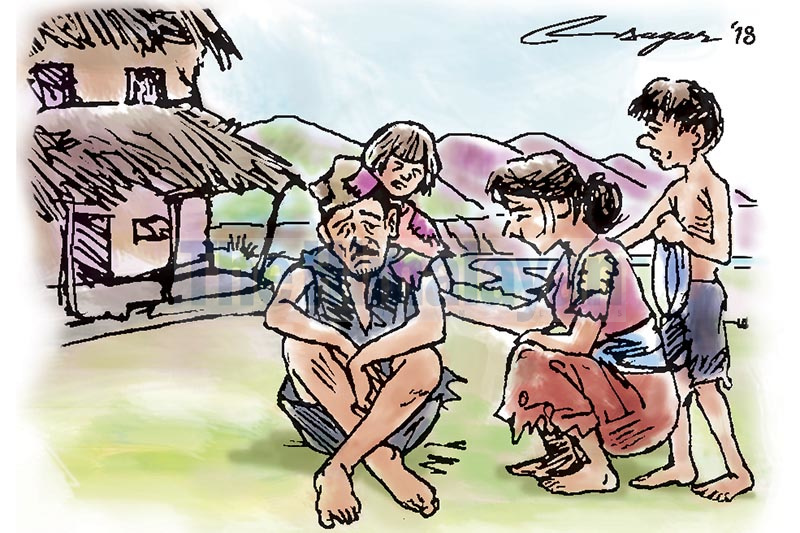Uncovering poverty amidst the pandemic: Better data required
The COVID-19 crisis provides an opportunity to innovate on the data front—by transforming the availability of data on jobs and economic activity in Nepal, by improving the use of existing data, and by investing in data systems at the federal, provincial and local levels to support their crisis response. In particular, there is a need to generate data more frequently to be able to analyse the evolving impacts of the crisis. For this purpose, the new and existing data from varied sources should be better integrated into data systems
Global poverty is expected to increase for the first time in over 20 years due to the COVID-19 pandemic.
The crisis will have a disproportionate impact on the poor, through job loss, loss of remittances, rising prices and disruptions in services, such as education and health care.
Up to 115 million people worldwide will fall into extreme poverty this year.
In Nepal, the exact scale and scope of COVID-19’s impacts on the poor are yet to be fully understood. This underscores the need for strengthening existing data systems on poverty and expanding the use of timely data on jobs, firms and economic activity.
Poverty in Nepal will likely have risen due to the reliance on remittances and the informal nature of the economy. Poverty reduction in the past has relied heavily on international migration. In 2011, 1 in 4 households received international remittances, and remittances currently account for 24 per cent of the GDP.
On the other hand, Nepal’s domestic labour market is characterised by a large informal sector. Only 17 per cent of the country’s 7.1 million wage earners are employed in the formal sector; the rest work with unregistered firms without social security benefits.
This sector will be hit hardest by the COVID-19 crisis.
At the same time, more than half of Nepal’s labour force is engaged in subsistence work, mostly in agriculture.
Subsistence workers tend to face higher risks of falling into poverty.
A heavy reliance on the informal sector, which contributes little to formal growth estimates but employs a significant share of the population—combined with an outdated base for measuring poverty and shared prosperity— means that the scale of the impact of the COVID-19 crisis on poverty in Nepal will be underestimated.
The last Nepal Living Standards Survey, which is used to estimate poverty for the country, was conducted in 2010.
Considerable uncertainty about the economic outlook makes it harder to plan for recovery, without better utilisation of the right types of data. Knowing the impacts of the crisis on the poor in Nepal and responding through relief, restructuring and recovery responses require not just updated poverty data, but also data on key correlates of poverty in Nepal, such as job loss, remittance loss and how people are coping with these losses.
The 2017 Labour Force Survey and the 2018 Economic Census can provide an accurate picture of pre-crisis economic activity and help identify vulnerable populations who will need to be reached in the relief, restructuring and resilient recovery response.
They can also provide a baseline to track and measure the impacts of the evolving COVID-19 crisis on the poor and informal sectors of the economy.
Proper use of these existing data will also serve as a base to measure the impacts of the COVID-19 response, allowing for proper adjustments as required.
The World Bank is supporting the Government of Nepal’s COVID-19 relief, recovery and resilience plan to help the country build back better and greener.
Saving lives and containing the pandemic are a foremost priority in the COV- ID-19 response plan that is spread over the immediate to medium and long-term.
The plan emphasises social protection platforms, including social protection support and ensuring children get the schooling needed and skills development, and support to firms that will be critical for economic recovery to take place.
Cross-cutting priority measures to ensure macroeconomic sustainability, to make essential infrastructure services green, and investments to scale up digitisation and the digital economy are added measures to help ensure a resilient recovery from the crisis.
But, at its core, any policy response will require better data that is more frequently collected on who needs to be reached, when they need to be reached and where they need to be reached, and what types of programmes will best assist them.
The COVID-19 crisis provides an opportunity to innovate on the data front— by transforming the availability of data on jobs and economic activity in Nepal, by improving the use of existing data, and by investing in data systems at the federal, provincial and local levels to support their crisis response. In particular, there is a need to generate data more frequently to be able to analyse the evolving impacts of the crisis.
For this purpose, the new and existing data from varied sources should be better integrated into data systems.
As a starting point, methods employed in other countries could be adopted in Nepal as well. A key example is the increasing adoption of telephone-based survey methods to regularly monitor labour markets—a commonplace activity in developed countries and one that is being adopted increasingly in developing countries as well.
The World Bank is already piloting a phonebased approach for labour surveys across South Asia to inform its operational response to this crisis. Such systems can have major benefits when embedded within national statistical offices. The key advantage is the possibility of building on existing sample frames that were used in the Nepali government’s largescale nationwide surveys to expand the analysis of COVID-19 impacts. These types of investments will allow for a rigorous analysis of the pandemic’s impact on the poor and those who work in the informal sector so that the needs of vulnerable groups such as these can be better reflected in policy responses.
Hadad-Zervos is the World Bank Country Director for the Maldives, Nepal and Sri Lanka






